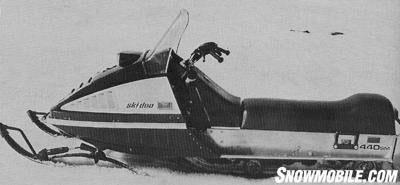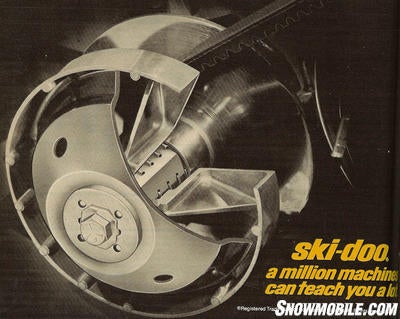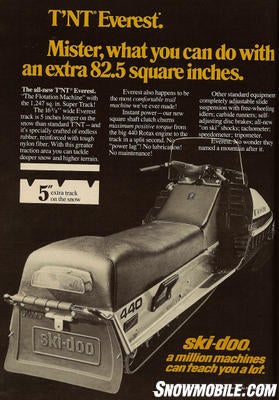1974 Ski-Doo T’NT 440 Everest

Ski-Doo's one-millionth snowmobile departed from 'Ski-Dog' past
With the appearance in 1959 of the original Bombardier ‘Ski-Dog’, snowmobiling as a recreational sport got underway. By 1974 Bombardier had manufactured than one million snowmobiles and celebrated the occasion by rolling a 1974 T’NT 440 Everest down its Valcourt, Que. assembly line. Nominated as the ‘One Millionth’ Ski-Doo, the 1974 Everest was a solid departure from the original model that got the sport going.
Joseph-Armand Bombardier spent decades developing over-snow vehicles that ranged from tracked troop carriers to tracked logging equipment. By 1959 he had developed a lightweight, single-tracked vehicle that he felt would allow people to have fun as they sped over the snow. He named this first recreational machine the ‘Ski-Dog’. The man who painted the logo on that first machine dropped the ‘g’ and added an extra ‘O’. Ski-Doo was born – and a recreational industry as well.
Bombardier’s lightweight snow vehicle sold slowly at first, but by 1965 Ski-Doo sales made the Quebec-based company one of the fastest growing businesses in all of Canada. By the end of the 1960s, Wall Street analysts predicted snowmobile sales would hit a million units annually. They were wrong, of course, but by 1974 Bombardier alone was to manufacture one million snowmobiles.
The One MillionthThe 1974 Ski-Doo T’NT 440 Everest rolled off the line to meet an assemblage of the world’s snowmobile press who had gathered in Valcourt to help Bombardier celebrate the occasion. In the 15 years since the Ski-Dog, snowmobiles had evolved, as had the sport. Sleds were faster, more powerful and able to go more places in the world’s snow belt.
As the sleds grew more sophisticated, so did the sport. There were provincial and state snowmobile associations bringing structure and the power of numbers to create an international system of snowmobile trails, organizations and political clout to protect the fledgling sport from those that disliked any form of motorized recreation.
Showcase Sled The 1974 Everest was sleekly styled and aluminum-bodied.
The 1974 Everest was sleekly styled and aluminum-bodied.
The Everest was a Ski-Doo showcase of sorts. As the number one retailer of snowmobiles, Bombardier was slow to change its successful formula. Engines mounted on the sled’s tunnel in front of the rider’s crotch and bogie wheel suspensions were the accepted standard of engineering early on, but some companies, like Arctic Cat, had their own ideas as to how a snowmobile should be designed.
The Thief River Falls, Minn. firm moved the engine off the tunnel and out by the skis and the bogie wheel suspension was replaced with a slide rail suspension. Cats featured aluminum construction and used cleated tracks instead of the rubber design favored by Ski-Doo. Add in clever advertising and continued development and you had the small company in Minnesota soon rivaling the French-Canadian original. To compete and retain its edge as No. 1, Bombardier reinvented the Ski-Doo snowmobile and the Everest is the result.
|
Invitation To Snowmobiling magazine stated: “The Everest is a big, fast, luxurious machine that will handle like a Porsche and out-snowmobile ninety percent of the 1974s – no matter what the terrain.” |
In fairness, just prior to the Everest, Ski-Doo had begun revamping its engineering protocols by moving the engine forward and offering its own versions of parallel rail rear suspensions. But it was really the T’NT Everest that got Ski-Doo returning to the concept of light-footed snowmobiling that it owned with its original Olympiques.
Designed To Climb
Because the Everest was designed to climb in powder and scale backcountry terrain, it was outfitted with a wide 16.5-inch track that provided 907.5 square inches of flotation. You might call the original Everest the snowmobile industry’s first crossover sled.
The chassis and track measured five inches longer than the standard T’NT models. The Everest track was not just wider, but replaced the traditional steel reinforcing rods with lighter, more flexible fiberglass rods. Steel was replaced with aluminum for the tunnel, though there was a steel reinforced bulkhead to hold the engine and ski mounts.
With oil-damped shocks assisting leaf spring skis for front suspension handling, the Everest showed off the latest in Bombardier rear suspension design. The ‘Torque Reaction Slide Suspension’ featured parallel rails and a rear-mounted tube shock to control travel. This design featured four adjustor cams which could be quickly and easily adjusted with the sparkplug wrench. Each plastic cam had four adjustment positions to stiffen or soften the suspension. Although limited in tunability, the concept was a first in giving snowmobilers quick and easy access to ride tuning on the trail.
Rotax Twin
Mounted forward of the fuel tank, the twin-cylinder Rotax engine sat low to give the Everest an exceptionally low center of gravity and balanced handling. The 436.6cc fan-cooled engine could pull the Ski-Doo beyond 60 miles per hour on hardpack, placing it in the upper end of fan-cooled sleds of the time. A single Tillotson HD carburetor sucked air through a canister-shaped breather, which featured an intake horn that could be moved forward to breathe from cowl-mounted louvers, or turned to the rear to avoid ingesting powder snow.
This model was one of the first to utilize the Square Shaft drive clutch, which replaced conventional standard splines and was said to effect more precise engagement with a modicum of driveline lag.
The longer chassis was covered with a new seat made of sandwiched layers of bonded foam, ethafoam and polyurethane foam. The 1970s was a time of evolutionary changes in many areas. Seat design was one. The Everest did away with the rear storage trunk normally located in the seat’s rear. Instead, there was thicker seat cushioning for a passenger. The leatherette seat cover was stickier to grip the rider better in deep snow conditions.
Standard Features
In this 1974 advertisement, Ski-Doo promoted the Everest’s five extra inches of track on the snow as increasing flotation in powder conditions.
Features that were becoming standard fare included a brighter headlamp with a new lens pattern that threw a wider, trail-illuminating beam. The fuel capacity went from six to 7.5 US gallons and the fuel dipstick was replaced with a sight-gauge cut into the sled’s console area around the fuel tank. There was a disc brake mounted on the driven clutch and although it was claimed to be a self-adjusting design, it required an occasional mechanical adjustment to maintain peak operation.
The 1974 Ski-Doo T’NT 440 Everest was long at nearly 107 inches in overall length with a narrow (by today’s standard) 28-inch center-to-center ski stance. Those dimensions, combined with the Everest’s above average flotation and the powertrain’s strong low-end performance, made this Ski-Doo a very strong deep snow performer.
In future years the T’NT Everest would evolve to include a luxury edition with a liquid-cooled, rotary-valve 440cc motor. Today Ski-Doo has resurrected the Everest name to represent its Summit deep powder sleds.
A Long History
As Bombardier’s choice to represent the million Ski-Doo snowmobiles built from 1959 through 1974, the T’NT Everest proved a wise one. The 1974 Everest showcased the ‘new’ Ski-Doo engineering direction of lightweight, sleekly styled, aluminum-bodied snowmobiles.
This model year Ski-Doo celebrates 50 years of snowmobiling that has gone from the first Ski-Dog in 1959 through the 1974 Everest to the current 2009 REV-XP. That’s quite a trail of achievements.
Related Reading:
1972 Coleman-Skiroule RT review










 Your Privacy Choices
Your Privacy Choices